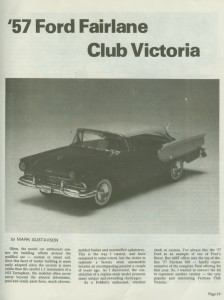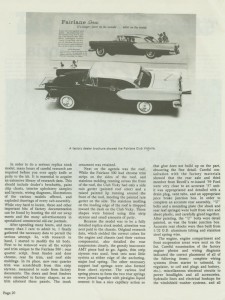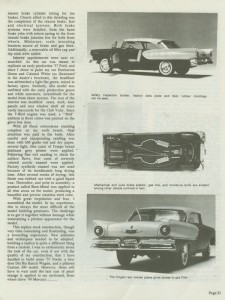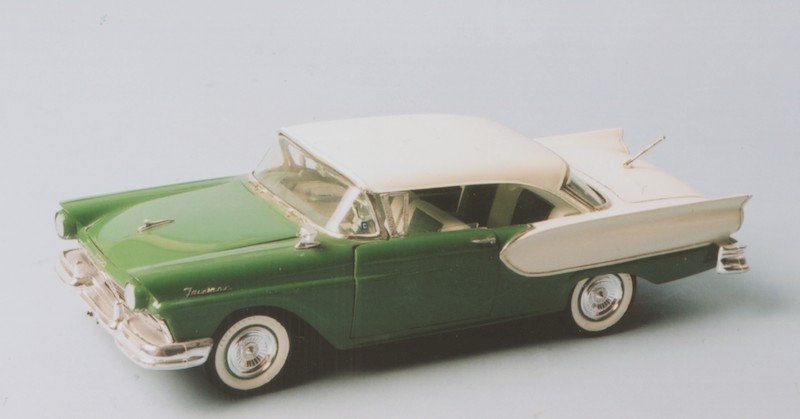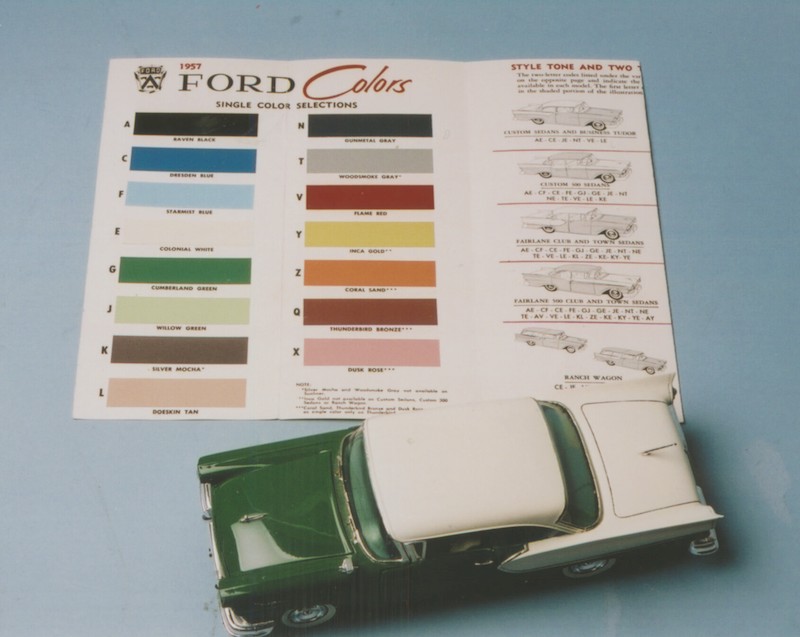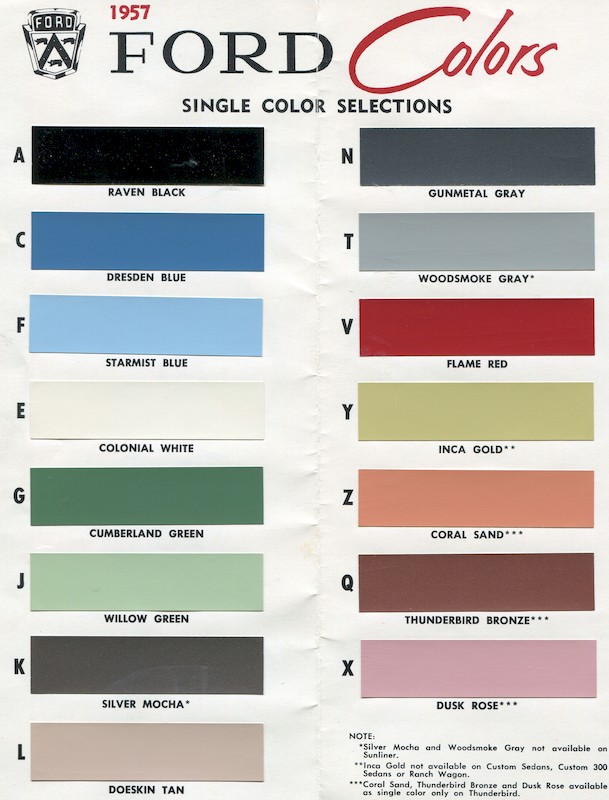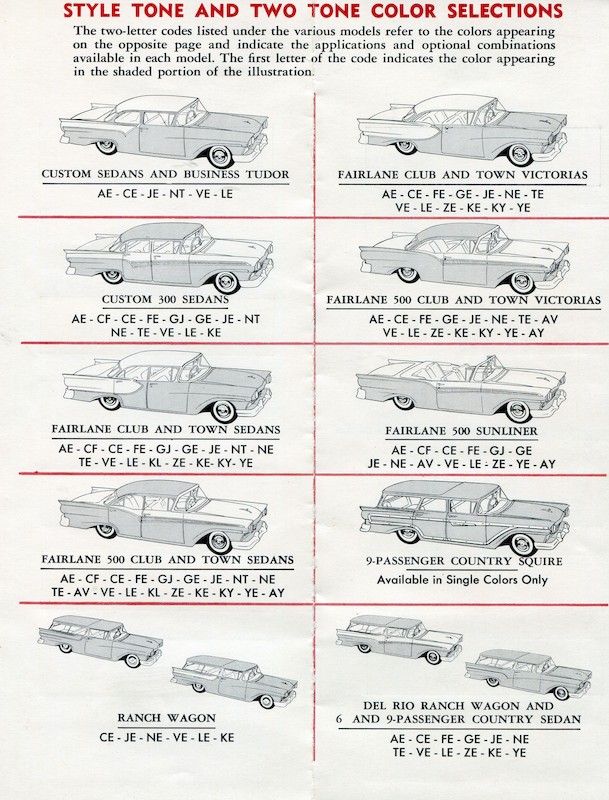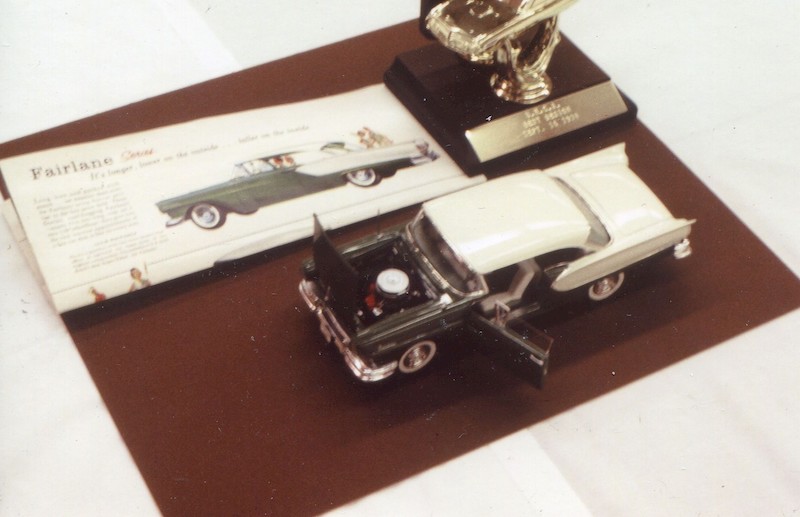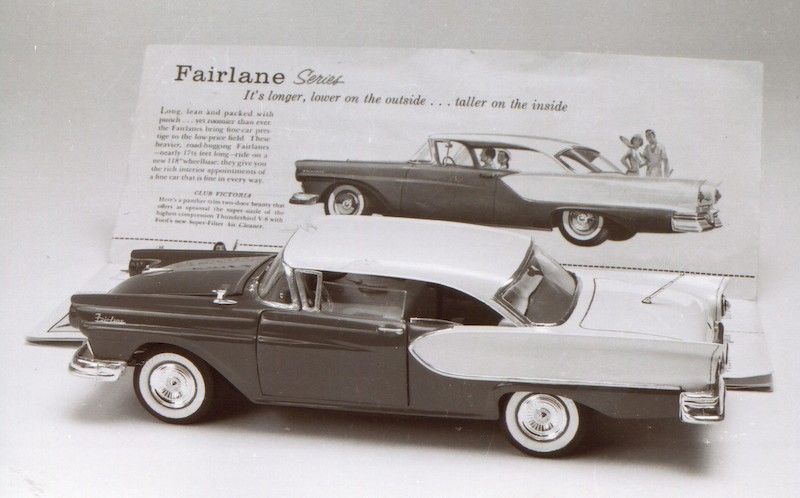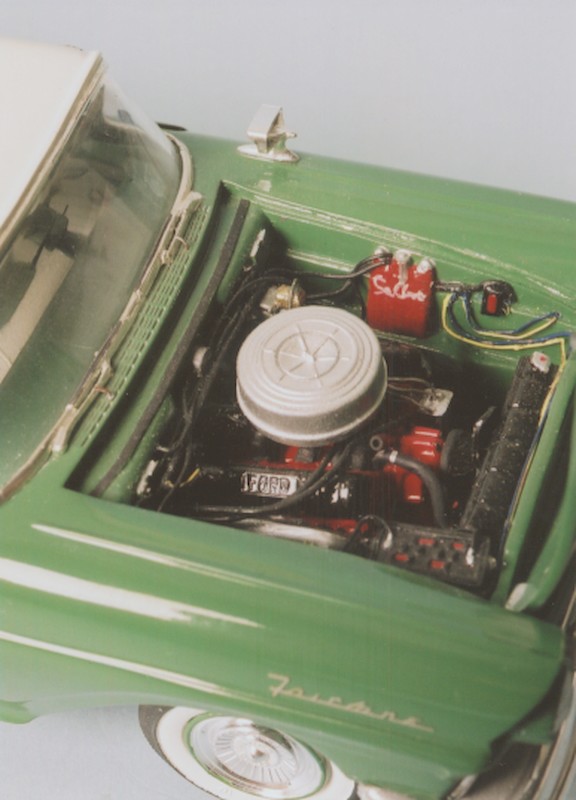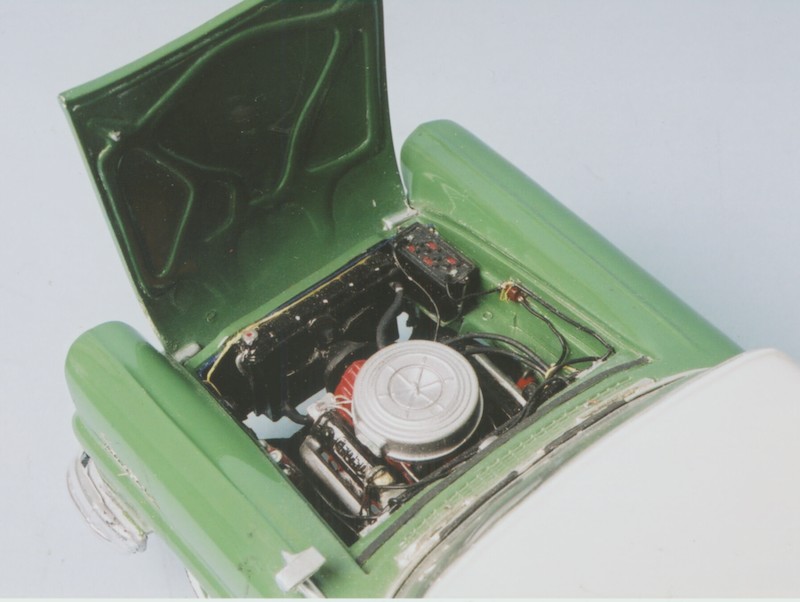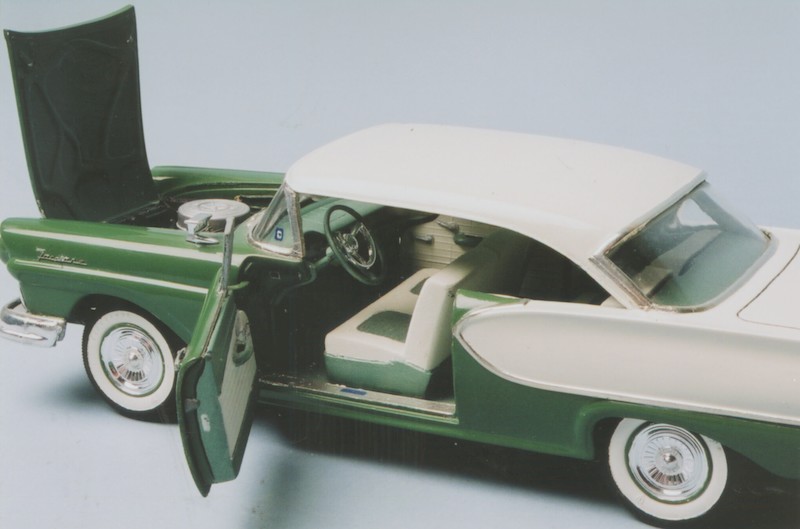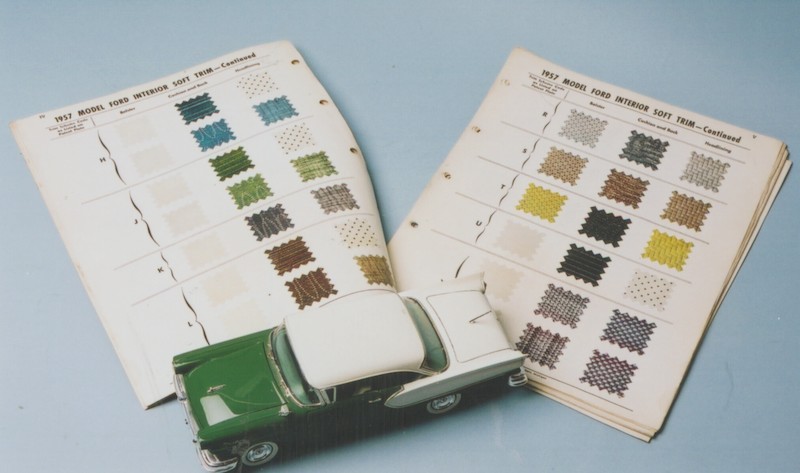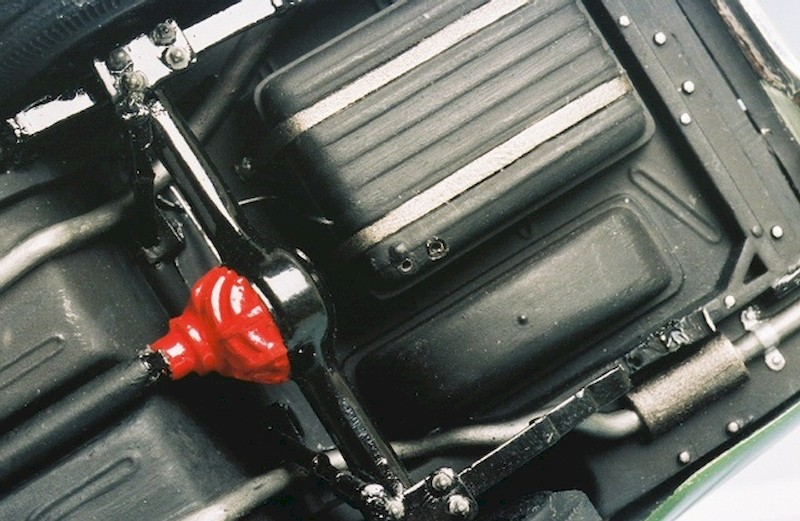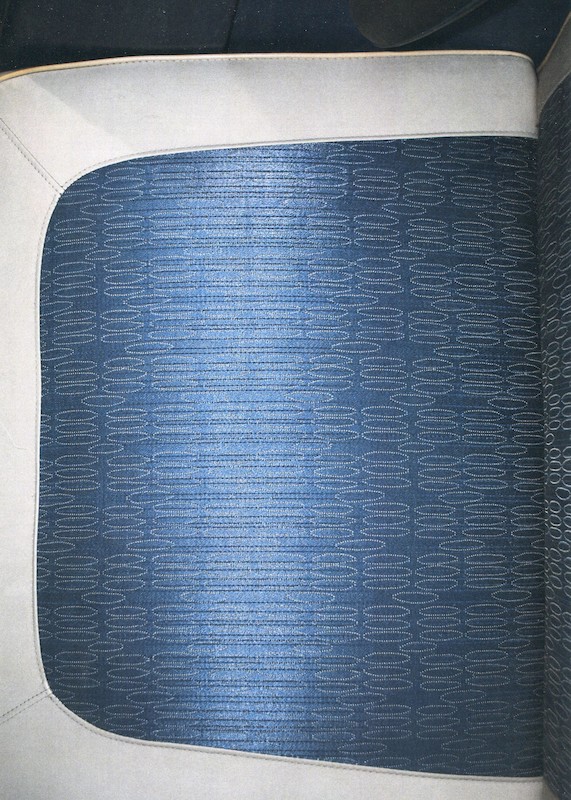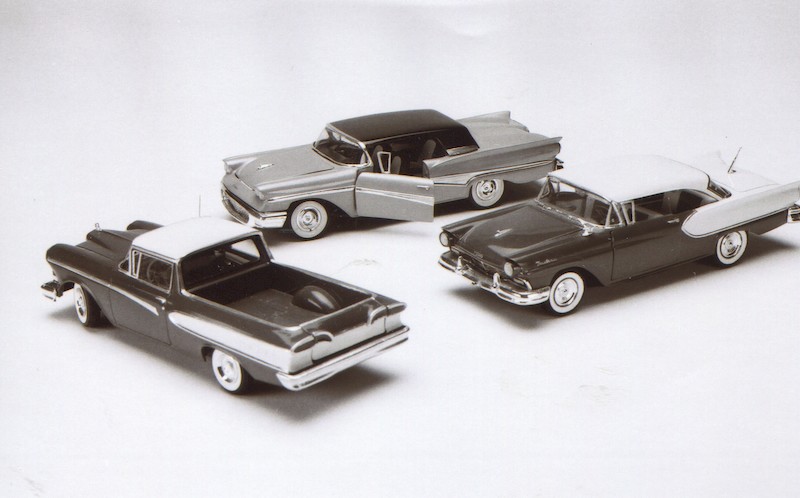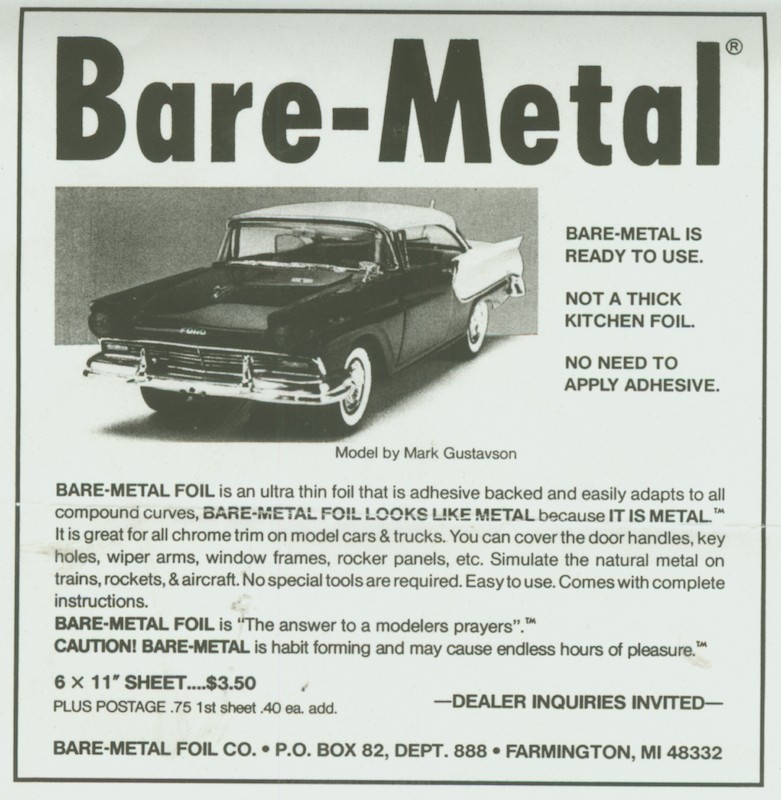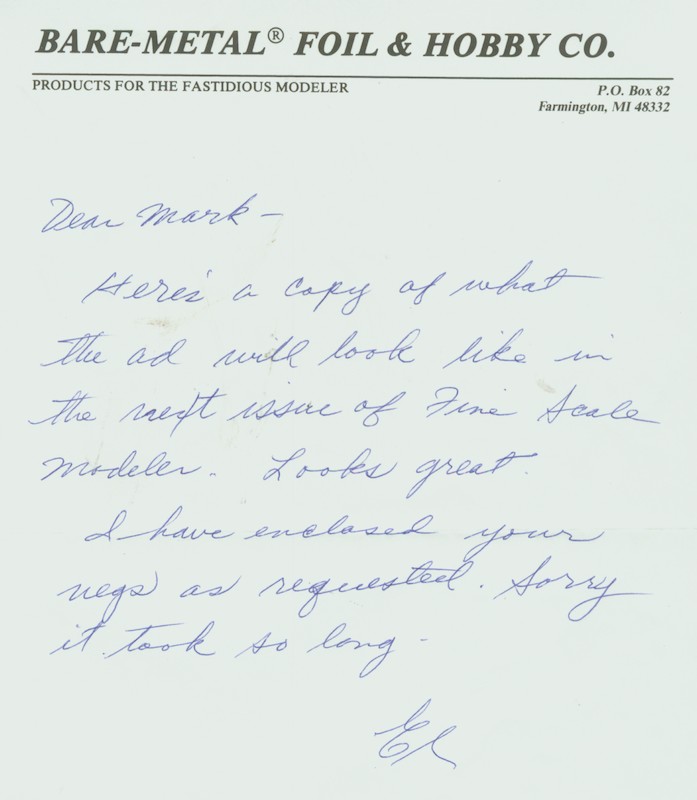My Original Model!
The original ‘57 Club Victoria model was essentially kit-based, of course. I started with the legendary 1962 AMT kit 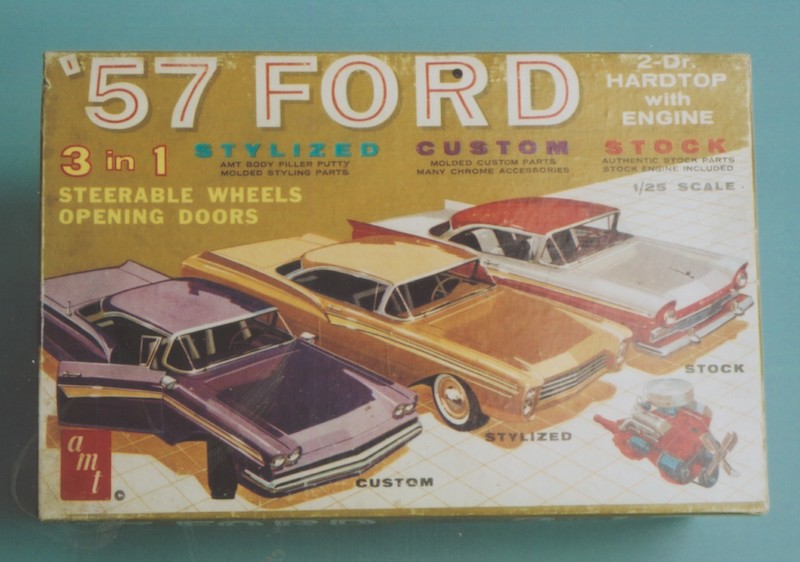
(rather than one of the re-issues) because it was handy at the time. In that build, I converted the body from the Fairlane 500 livery to the Club Vicky-level trim, scratchbuilt a few components, moderately (and inaccurately!) detailed the engine and engine compartment, added working headlights and taillights, and painted the model with DuPont Centari acrylic enamels (mixed in the original colors) in the factory Colonial White over Cumberland Green paint scheme. As I built the model, I discovered the limitations of the AMT kit: the crude door hinges (the passenger door had to be glued shut because it wouldn’t fit otherwise!), the grossly inaccurate inner fender wells in the engine compartment, and the combined frame/floorboard exhaust system unit are not high points in the kit. Nevertheless, the basic body dimensions and shapes are almost perfect!
My original Vicky model was entered in a number of local Utah contests where it did well except against the work of George Layton in one contest: he bested me because I forgot to install the lower radiator hose. Needless to say, I fixed that omission quickly! Later, the model appeared in Model Car Journal and on the inaugural first issue of Scale Auto (on the cover, too!) where it was the first major feature article on a model in the Renaissance of the model car hobby as famed builders Juha Airio and Rick Hanmore have recently remarked in notes to me:
The Vicky model created quite a stir, apparently, especially measured against my outburst in my first Scale Auto Enthusiast Putty Thrower column. Coming at the outset of the public renaissance of the model car hobby, it was a significant (and quite flawed) model that took itself and the hobby seriously.
The following quotes represent the reaction of many in the model car hobby:
Tim Boyd: In case anyone doubted the importance of this model at the time it was originally published, the ensuing years have only made its significance all the more important. This model largely established the model building genre of modified replica stock models, and between its incorporation of modifications to a kit to replicate a different series/trim level, and the emphasis on 100% restored stock (vs. a street machine, custom, or drag racing theme), it predicted trends that were to become a major part of the model car world in the years and decades to come. Well done, Mark!
Rick Hanmore: Mark’s ’57 Vicky on the cover of Scale Auto #1 was the spark that re-ignited the model car hobby. It was the right magazine with the right model at the right time.
Juha Airio: Your ’57 Ford Victoria build (and the subsequent article in the Scale Auto Enthusiast premier issue) was very important for the entire plastic model car community at the time when the hobby almost seemed to be fading away.
You might be interested in the following photo essay on my original 1978-built Club Vicky model:
The original model was built to represent a car depicted in one of the original Ford advertising brochures. I thought that the Cumberland Green would be a brighter color (based on the factory brochure) than it turned out to be and was disappointed with the shade. I would only later find a factory paint brochure which, if in hand, would have alerted me to the real tone of the green color.
Before the time I built the original model, I’d purchased this factory color brochure from a vendor in Hemmings Motor News which disclosed the correct two-tone combinations. The colors were sprayed from 16 ounce, custom-mixed spray cans, in uncatalyzed DuPont Centari: it took about 3 weeks for the paint to dry before I could wax the surface though, truth be told, the paint was shiny as applied and only one small spec of dust appeared on the trunk (I painted the model mounted on a hangar and outside my back door – that was a time before my paint booth). This paint job was laid down just before George Layton taught me how to airbrush acrylic lacquer.
While every domestic manufacturer printed these color cars or brochures, the colors were occasionally inaccurate because of the natural problems in getting a four-color press to correctly replicate the tones and colors of synthetic enamel applied to sheetmetal. These brochures would typically indicate factory-authorized color combinations, too.
While embarrassingly amateurish in 2014, this was a marginally-good model when it was built. I drilled out the aircleaner intake snout, placed the ignition wires (but not correctly), commissioned one-off valve cover decals, hand painted what I thought was the correct logo on the sill plate (wasn’t accurate) created with Bare Metal Foil, and hand-painted the “Fairlane” script on both sides of the front fender. Note, also the latching “hooks” on the two opposing corners at the back of the hood which was inaccurate since the car has only a single latch. I displayed the factory brochure with the model. I think selecting white and green factory colors was hardly the most ‘visual” of color schemes for the ‘57 Ford –helped create an “air” of seriousness about the model.
This photo was taken just after the model’s debut at the Utah Model Car Association’s 1978 annual contest. With a section of the factory brochure in the background to which I referred when building my model (it showed a green and white car), you can see where the shape of the model’s rear quarter side molding isn’t accurate: On the 1:1 car, the initial downwardly-angled extension is straighter than depicted on the model, and the apex of the curve is both higher and more pointed than I portrayed it. I also added a rear deck antenna (a rare option on the ‘57 Fords) and an accessory outside rear view mirror. Note the hand-painted “Fairlane” script on the forward of the front fender – later, I polished off the silver paint and placed Putty Thrower “Fairlane” photoetched scripts there.
Seen from the passenger side, the valve covers seen here are the first version before I applied – – to the correct smooth valve covers – – the miniature rub-on transfer correct valve cover decals from Ted Nagata. The voltage regulator isn’t accurately placed – it should be on the rearward facing side of the radiator support, on the driver’s side, facing the firewall. I did try to portray the rubber weather strip on the cowl but it’s way too wide. Note that there are no fender-to-inner engine compartment panel bolts. I devoted a lot of attention to the engine compartment without once being able to look at a 1:1 scale engine or under the hood of a ‘57 Ford! I relied only upon Ford illustrated parts catalog drawings to build the block and add detail. The radiator hoses are basically in the right place, but the heater hoses meet the firewall in the wrong place. The master cylinder from the JoHan Turbine Car kit was used because it most closely matched the Ford piece; these days, Norm Veber sells an accurate resin cast piece.
Some real problems show up here. First, there are the grossly-inaccurate AMT kit “hinges” (actually, just pivot points – – an unavoidable detail in a production kit.). Then, you can see the driver’s side hood-latch on the underside of the hood. And the hood is way too thick to be realistic – the hood for the new Vicky models will be hammered from .020 brass.
In this later photo, the Putty Thrower photoetched script can be seen on the front fender (in the model’s first version, the script was painted by hand using a 5-0 brush). I attempted to portray a correct door jamb, but missed by a mile. Bare Metal Foil was used to simulate a door sill plate – in the new model, this part will be photoetched thanks to Bob Wick’s superb artwork and Gary Kulchock’s digitalization of the same for photocutting. I got the roof right, and I correctly recessed the top of the backlight as a factory photo depicted the setup.
In 1998, I purchased a very rare actual dealership upholstery sample set. The correct upholstery sample for this first Vicky is the second set on the left, though I neither knew of the pattern detail nor could I have come near to even suggesting that detail in 1978: I simply used paint to simulate a generic pattern.
I used miniature DC bulbs from Utah Pacific to illuminate the head and tail lights on my first Vicky. Power gets into the model by placing to brass “probes” into the very small holes on the side of the gas bank. While the lights still work, this wasn’t a very elegant way to get power into the model!
The correct upholstery pattern for the new model – the correct color/pattern can be seen here on the upper left set. I’ll be commissioning specialized scale decals to replicate the factory cloth seat inserts.
In 1980, and as an outgrowth of my deep interest in phantom factory concept cars, I approached two great friends and terrific modelers – Rick Hanmore and Andy Martin – and asked them to build two faux 1957-1958 “concept cars.” Andy built the ‘58 Edsel Ranchero (he christened it the “Edchero”!). Presciently, Andy used a 1959 Ford windshield set up along with parts from a very rare vintage 1958 AMT Edsel kit. The model is painted red and white – it’s still in great shape. Rick built the “Thunderlane” in the back – a stylistic send up on the ‘57 Skyliner: the body wasn’t as long as the production retractable Ford, the T-Bird top didn’t fold into the trunk, and it ran a Squarebird front bumper from the Monogram ‘58 ‘Bird kit. He also built a supercharged 312 engine for it. Both models are still in excellent condition – a tribute to the craftsmanship of these top-shelf builders.
My Vicky model received an unexpected tribute by being featured in a display advert for the famed Bare Metal Foil Company. Eldred Mason contacted me and asked if he could use a picture of the model to promote his excellent product.
I was thrilled to see my Vicky model pictured in Eldred’s advertising campaign in Fine Scale Modeler which I believe occurred in the mid-Eighties. I wish I had worked harder on the grille to “open it up” so that it didn’t obviously depict a black-insert painted AMT kit part.
Eldred sent me this nice note after the advert had been created and submitted to FSM.
My original model is still in pretty good condition though the years have brought some deterioration to it: the delicate strip styrene rear leaf springs have broken, the driver’s door has sagged, and little things have been re-attached. The paint is still in great shape, but there’s no escaping the reality that the model is very crude by contemporary building standards. However, the headlights and taillights still work!
The first of my three, new scale miniature Vicky models will attempt to replicate my Gemma Jackson1:1 car (before it was modified) with one change: I’m going to build the McCullough Supercharged engine using some of the blower parts from a follow-up issue of the Revell kit (substantially enhanced). Of course, I hopefully will be able to avoid the many scale compromises and inaccuracies of my original model. Boldly, I also intend to set a new standard in our hobby – in 1/25 scale – for all three of the Vicky models. It will be interesting to see if I can do this – there’s great work being done in 1/25 scale! It will be an interesting comparison between the original model and the speculative design study based upon the ‘57 Vicky, and I can’t wait to see the wailing gnashing of teeth that will probably emerge when I don’t treat the idea of a slot car as anathema to the hobby I love.

